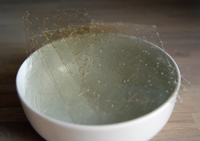
Photo from wikipedia
Abstract Objective To determine the chemical structure, tensile strength, porosity, and degradability of polyvinyl alcohol (PVA)–collagen–hydroxyapatite (HA) composite membranes for guided tissue and bone regeneration. Materials and Methods The PVA–collagen–HA… Click to show full abstract
Abstract Objective To determine the chemical structure, tensile strength, porosity, and degradability of polyvinyl alcohol (PVA)–collagen–hydroxyapatite (HA) composite membranes for guided tissue and bone regeneration. Materials and Methods The PVA–collagen–HA composite membrane was divided into three groups: the group without irradiation, the group with 15 kGy irradiation, and 25 kGy irradiation. Each group was tested for chemical structure with Fourier-transform infrared (FT-IR) at a wavelength of 400 to 4,000 cm −1 . Tensile strength test was tested in dry and wet conditions with the standard method of American Standard Testing Mechanical (ASTM) D638, and porosity using scanning electron microscope and analyzed using ImageJ software. Degradability test immersed in a solution of phosphate-buffered saline. Data were analyzed using analysis of variance (ANOVA) and Tukey's test. Results FT-IR test before and after storage for 30 days on three media showed a stable chemical structure with the same functional groups. ANOVA analysis showed a significant difference ( p < 0.05) in the dry condition ( p = 0.006), Tukey's test showed a significant difference in the 15 kGy and 25 kGy irradiated groups ( p = 0.005), but the groups without irradiation had no significant difference with the 15 kGy ( p = 0.285) and 25 kGy ( p = 0.079) irradiation groups. In wet conditions, there was no significant difference ( p > 0.05) in each group ( p = 373). The size of the porosity in the group without irradiation, 15 kGy irradiation, and 25 kGy irradiation showed a size of 4.65, 6.51, and 8.08 m, respectively. The degradability test showed a decrease in weight in each group, with the total weight of the membrane being completely degraded from the most degraded to the least: the groups without irradiation, 15 kGy irradiation, and 25 kGy irradiation. The ANOVA test on the degradability test shows significant ( p < 0.05) in the PVA–collagen–HA composite membrane group over time intervals ( p = 0.000). Tukey's post hoc test showed a significant difference ( p < 0.05) after 1 week between the groups without irradiation with 15 kGy ( p = 0.023). Conclusion PVA–collagen–HA composite membrane has a stable chemical structure, optimal tensile strength, porosity, and ideal degradability as guided bone regeneration and guided tissue regeneration.
Journal Title: European Journal of Dentistry
Year Published: 2023
Link to full text (if available)
Share on Social Media: Sign Up to like & get
recommendations!